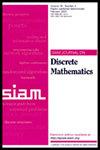几何网络创建游戏
IF 1
3区 数学
Q2 MATHEMATICS
引用次数: 0
摘要
SIAM 离散数学杂志》,第 38 卷,第 1 期,第 277-315 页,2024 年 3 月。 摘要网络创建博弈是一种著名的解释和分析现实世界网络结构、质量和动态的方法。在这些博弈中,与网络中节点相对应的自私代理会策略性地购买附带边来提高自己的中心地位。然而,过去对这些博弈的研究只考虑了创建具有单位权重边的网络。在实践中,例如在构建光纤网络时,选择连接哪些节点以及链接的诱导价格在很大程度上取决于相关节点之间的距离,而这种情况可以通过边权重图来建模。我们将 Fabrikant 等人的著名模型[PODC'03 论文集,ACM,2003 年,第 347-351 页]推广到边缘加权主机图,并将重点放在几何设置上,即权重是由某个度量空间中的距离引起的。在单位权重版本中,无政府状态的价格被猜测为常数,而解决这个问题是一个重大的未决难题。与此形成鲜明对比的是,我们证明了公度量版本中无政府状态价格的严格非常数约束,以及非公度量情况下稍弱的上界。此外,我们还分析了几个自然度量的均衡存在性、计算难度和博弈动态。我们提出的模型可以看作是经典网络设计问题的博弈论类似物。因此,我们博弈的低成本均衡点对应于最优网络设计的分散和稳定近似值。本文章由计算机程序翻译,如有差异,请以英文原文为准。
Geometric Network Creation Games
SIAM Journal on Discrete Mathematics, Volume 38, Issue 1, Page 277-315, March 2024.
Abstract. Network creation games are a well-known approach for explaining and analyzing the structure, quality, and dynamics of real-world networks that evolved via the interaction of selfish agents without a central authority. In these games selfish agents corresponding to nodes in a network strategically buy incident edges to improve their centrality. However, past research on these games only considered the creation of networks with unit-weight edges. In practice, e.g., when constructing a fiber-optic network, the choice of which nodes to connect and also the induced price for a link crucially depend on the distance between the involved nodes, and such settings can be modeled via edge-weighted graphs. We incorporate arbitrary edge weights by generalizing the well-known model by Fabrikant et al. [Proceedings of PODC ’03, ACM, 2003, pp. 347–351] to edge-weighted host graphs and focus on the geometric setting where the weights are induced by the distances in some metric space. In stark contrast to the state of the art for the unit-weight version, where the price of anarchy is conjectured to be constant and where resolving this is a major open problem, we prove a tight nonconstant bound on the price of anarchy for the metric version and a slightly weaker upper bound for the nonmetric case. Moreover, we analyze the existence of equilibria, the computational hardness, and the game dynamics for several natural metrics. The model we propose can be seen as the game-theoretic analogue of the classical network design problem. Thus, low-cost equilibria of our game correspond to decentralized and stable approximations of the optimum network design.
Abstract. Network creation games are a well-known approach for explaining and analyzing the structure, quality, and dynamics of real-world networks that evolved via the interaction of selfish agents without a central authority. In these games selfish agents corresponding to nodes in a network strategically buy incident edges to improve their centrality. However, past research on these games only considered the creation of networks with unit-weight edges. In practice, e.g., when constructing a fiber-optic network, the choice of which nodes to connect and also the induced price for a link crucially depend on the distance between the involved nodes, and such settings can be modeled via edge-weighted graphs. We incorporate arbitrary edge weights by generalizing the well-known model by Fabrikant et al. [Proceedings of PODC ’03, ACM, 2003, pp. 347–351] to edge-weighted host graphs and focus on the geometric setting where the weights are induced by the distances in some metric space. In stark contrast to the state of the art for the unit-weight version, where the price of anarchy is conjectured to be constant and where resolving this is a major open problem, we prove a tight nonconstant bound on the price of anarchy for the metric version and a slightly weaker upper bound for the nonmetric case. Moreover, we analyze the existence of equilibria, the computational hardness, and the game dynamics for several natural metrics. The model we propose can be seen as the game-theoretic analogue of the classical network design problem. Thus, low-cost equilibria of our game correspond to decentralized and stable approximations of the optimum network design.
求助全文
通过发布文献求助,成功后即可免费获取论文全文。
去求助
来源期刊
CiteScore
1.90
自引率
0.00%
发文量
124
审稿时长
4-8 weeks
期刊介绍:
SIAM Journal on Discrete Mathematics (SIDMA) publishes research papers of exceptional quality in pure and applied discrete mathematics, broadly interpreted. The journal''s focus is primarily theoretical rather than empirical, but the editors welcome papers that evolve from or have potential application to real-world problems. Submissions must be clearly written and make a significant contribution.
Topics include but are not limited to:
properties of and extremal problems for discrete structures
combinatorial optimization, including approximation algorithms
algebraic and enumerative combinatorics
coding and information theory
additive, analytic combinatorics and number theory
combinatorial matrix theory and spectral graph theory
design and analysis of algorithms for discrete structures
discrete problems in computational complexity
discrete and computational geometry
discrete methods in computational biology, and bioinformatics
probabilistic methods and randomized algorithms.

 求助内容:
求助内容: 应助结果提醒方式:
应助结果提醒方式:


